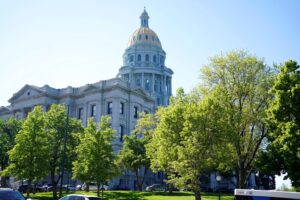TABOR: The enduring success story empowering Colorado taxpayers
BY BARRY W. POULSON, OPINION CONTRIBUTOR – 03/22/24 7:00 AM ET
 AP Photo/David Zalubowski
AP Photo/David Zalubowski
The dome of the State Capitol shines in the early morning sun Friday, May 28, 2021, in downtown Denver. (AP Photo/David Zalubowski)
Even as economists tout a soft landing for the U.S. economy, Americans are facing sticker shock at the grocery store, the gas pump, and fast-food restaurants, among other places.
After a long bout of double-digit inflation, not unlike that of the 1970s. We have learned once again that unconstrained growth in federal spending funded by borrowing and accommodative monetary policy eventually triggers high inflation.
In response to stagflation in the 1970s, Congress enacted statutory fiscal rules designed to balance the budget and stabilize debt. The Federal Reserve also pursued tighter monetary polies to stabilize prices. In the 1990s, a period referred to as “The Great Moderation,” the federal government achieved sustainable debt levels and low rates of inflation.
Unfortunately, over the last two decades, the federal government largely abandoned these fiscal and monetary policies. Federal spending has far outpaced the growth in national income, and federal debt has grown at an unsustainable rate. The statutory fiscal rules designed to constrain federal spending are routinely circumvented and suspended.
The Federal Reserve has again used monetary policy to accommodate these fiscal policies, resulting in wide swings in the rate of inflation. It is difficult to argue that we are experiencing a soft landing and that all is well. A more realistic forecast is that over the next decade we will again experience stagflation.
But there is a bright spot in this gloomy outlook.
In response to stagflation in the 1970s, citizens launched state and local tax revolts. Beginning with property tax limitations in California, citizens began to challenge profligate fiscal policies at the state and local level. Using the initiative and referendum, citizens enacted tax and expenditure limits to constrain fiscal policies.
Citizens learned an important lesson from their earliest efforts as politicians and special interest groups found ways to circumvent and suspend the new fiscal rules at the state and local level, just as they had done at the federal level. A good example is Colorado, which was one of the first states to enact a statutory tax and expenditure limit. In the 1970s, this measure constrained state spending, and for several years citizens received tax rebates of surplus revenue above the tax and expenditure limits. However, by the early 1980s, politicians had exempted much state spending from the limit. State spending therefore again grew more rapidly than state income.
This triggered a new tax revolt in Colorado. In 1992, citizens used the initiative to enact the Taxpayer Bill of Rights (TABOR) Amendment, one of the most effective tax and expenditure limits enacted in any state.
The key to the success of TABOR is that it is a constitutional fiscal rule designed by citizen taxpayer organizations. Over the years, politicians and special interest groups have attempted to weaken and eliminate TABOR, but its essential provisions remain intact. TABOR imposes a strict cap on the growth in state spending linked to inflation and the rate of population growth. Surplus revenue above the limit must be returned to taxpayers through rebates. And if any government in Colorado wants to increase taxes or revenue, issue new debt, or spend surplus revenue, it must first gain citizen approval.
TABOR was enacted in an era when Colorado was a solid red state. Colorado has since become a blue state, with Democrats now in control of the legislature and most major state offices. Yet TABOR has survived during both Republican and Democratic administrations. Whatever their political persuasion, Colorado citizens have learned to live with their constitutional fiscal rules and are not about to give up these constraints on fiscal policy. TABOR allows citizens to decide how much government they want and are willing to pay for.
With TABOR, Colorado citizens exercise choice over how their tax dollars are spent. Hundreds of ballot measures have been presented to taxpayers asking for increased taxes and debt, and requesting expenditure of surplus revenue rather than tax rebates. Citizens express their preference at the ballot box, often approving these measures at the local level; but most of the state ballot measures have been rejected. Citizens choose not only how their tax dollars are spent, but also their preference for local government spending versus spending at the state level.
When citizens express their choice at the ballot box, they effectively tell politicians to live within a budget constraint, much like so many Americans economizing in order to live within their budgets.
With TABOR, Colorado citizens imposed a hard-nosed budget constraint on state and local governments. Citizens are saying to politicians that if we must live within a family budget constraint, you should learn to live within a budget constraint as well. Whatever their political persuasion, citizens value the fiscal rules that impose this budget constraint on politicians. TABOR reveals that we are all fiscal conservatives, and that people of any political stripe can take away from politicians the choice to overspend.
Barry W. Poulson is an emeritus professor of economics at the University of Colorado and a policy advisor with the Heartland Institute.
Leave a Reply